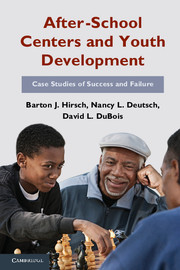Book contents
- Frontmatter
- Contents
- Figure and Tables
- Preface
- Introduction
- Midwest Center
- North River Center
- West River Center
- 10 The Jewel in the Crown
- 11 Midnight: A Teen Father Stays the Course
- 12 Tommiana: A Contest between Closeness and Competition
- 13 Putting It All Together: What Have We Learned?
- Conclusion
- Appendix Data Sources
- References
- Index
13 - Putting It All Together: What Have We Learned?
Published online by Cambridge University Press: 05 June 2012
- Frontmatter
- Contents
- Figure and Tables
- Preface
- Introduction
- Midwest Center
- North River Center
- West River Center
- 10 The Jewel in the Crown
- 11 Midnight: A Teen Father Stays the Course
- 12 Tommiana: A Contest between Closeness and Competition
- 13 Putting It All Together: What Have We Learned?
- Conclusion
- Appendix Data Sources
- References
- Index
Summary
We now need to take stock of what broader insights can be gleaned from our studies of the West River center. As it is the last center we will be examining, we use this chapter as an opportunity to integrate our findings across our studies of all three centers. Our aim in doing so is to arrive at a set of conclusions regarding the conditions under which comprehensive after-school centers are most likely to realize their potential for promoting positive youth development. Our conclusions provide the foundation for the practice recommendations that we present in the next and final chapter.
West River is the strongest of the after-school centers we examined on most dimensions. So it is natural to use this center, and our studies of youth there (Midnight and Tomianna), as a counterpoint to many of the weaknesses and limitations that are apparent for the Midwest and North River centers. Our intention is not to suggest either that the latter centers are entirely lacking in positive features or that West River is without areas in need of improvement. Neither of these, of course, is the case. Indeed, as we will discuss, there are some concerns that stand out as in need of attention at all three centers and, we suspect, to a large degree among comprehensive after-school centers more generally. As researchers, this process of comparing and contrasting is one of our major analytic tools.
- Type
- Chapter
- Information
- After-School Centers and Youth DevelopmentCase Studies of Success and Failure, pp. 282 - 294Publisher: Cambridge University PressPrint publication year: 2011



